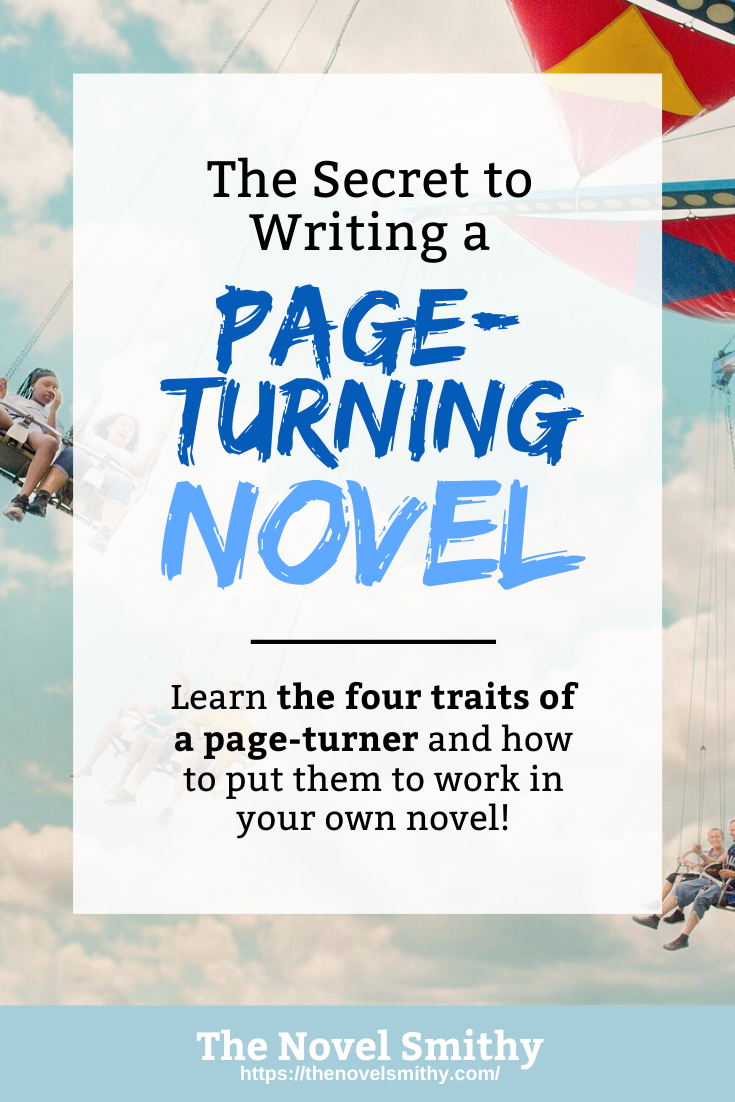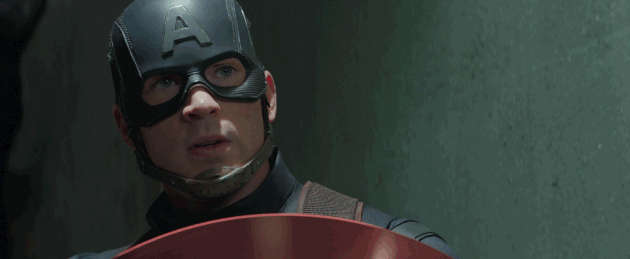The Secret to Writing a Page-Turning Novel
Page-turners are novels you simply can’t put down…
Page after page, word after word, these stories grip you from beginning to end—and as a result, nearly every writer dreams of creating a page-turning novel of their own. Of course, actually creating this effect is another thing entirely. As invested as we may be in our own stories, creating that same investment in our readers isn’t easy!
Fortunately, writing a page-turner isn’t rocket science. All you need are four elements of story structure, as well as a few tricks for leveraging a writer’s greatest weapon—narrative drive.
What Makes a Page-Turning Novel?
Contents
 First and foremost, we should probably answer an important question:
First and foremost, we should probably answer an important question:
Why do writers care about writing a page-turner?
This is a fair question to ask, considering there are a whole variety of important elements that can determine a novel’s success—from diverse characters to how it leverages its conflict, to the author’s writing style itself.
However, the reality is, most readers don’t have enough time to read every book they’re interested in. As a result, they have to make quick judgements about each novel they pick up to maximize their limited reading time—if the story doesn’t grip them immediately, it goes back on the shelf.
This is where writing a page-turner comes in.
Page-turning novels grip readers from the very first word and don’t let go until the very last. As much as we would all love to have unlimited reading time, very few of us do, so these are the kinds of novels we gravitate towards. There’s no wasted space, and every scene feels important—meaning we can’t help but say “just one more page.”
Of course, the term “page-turner” doesn’t actually tell you much about how to achieve this effect. How do you write a page-turning novel of your own? Well, the secret ingredient is actually quite simple, and it’s called narrative drive.
How to Create Narrative Drive
When it comes to writing a page-turner, the name of the game is narrative drive.
Put simply, narrative drive is the forward momentum of your story.
This is what keeps your plot moving, your characters adapting, and your readers reading. Most importantly, narrative drive is what creates the sensation that there’s always something important happening in your story—even during slower scenes.
When it comes to writing a page-turner, the name of the game is narrative drive. #amwriting Share on XIn fact, narrative drive is vital to every kind of story—not all stories can be high-paced thrillers, after all! Plenty of readers feel glued to the page even during cozy romance novels, all thanks to the power of narrative drive. Of course, you’re probably wondering what creates this drive.
Well, according to Robert McKee, narrative drive is created by two things: curiosity, and concern.
Your Readers’ Curiosity:
First up, we have curiosity.
At its core, curiosity is all about your plot. This is the feeling readers get when they’re engaged with your story’s action and external conflict, and it’s what causes them to start asking:
“What happens next?”

For example, consider Captain America: Civil War. This movie glues audiences to their seats, because viewers are curious if the heroes will manage to outwit the villain and save the team. However, that’s not the only thing this movie has to offer, which is where concern comes in.
Your Readers’ Concern:
The partner to curiosity, concern is focused on your characters.
This is the feeling your readers get when they’re invested in your characters’ happiness, wellbeing, and success. Specifically, this is the feeling that helps push your readers through slower, more character-driven scenes—while these scenes may be lacking in physical conflict, there’s still plenty of internal conflict to go around!

Returning to Captain America, concern is what truly makes this movie a fan-favorite.
By this point, audiences were already invested in the relationships between the Avengers, so watching the team fracture thanks to the villain’s meddling is hard to look away from. This is especially true of the relationship between Steve and Tony—even as everything falls apart, viewers are still concerned for their friendship, and will stick around in hopes it can survive.
How to Leverage These Feelings:
Of course, curiosity and concern are great on their own, but where they really shine is when they work together.
When used in combination, curiosity can drive your more action focused story beats, while concern will keep your reader coming back even when your story needs time to slow down. Different stories will naturally focus on one of these over the other, but all stories can benefit from a bit of both.
This is especially true if you want to write a page-turner.
Page-turning novels need to keep their readers engaged in every scene, but not every scene will be a treasure trove of spine-tingling action. Likewise, not all scenes can have deep character development or drama. Instead, a successful page-turner will have to balance both curiosity and concern to keep up its narrative drive.
Fortunately, striking this balance is not impossible. It simply requires four key traits:
- A strong Hook
- A compelling Dramatic Question
- Scene structure
- Chapter structure
The Four Traits of a Page-Turning Novel
The Hook:
If you’re unfamiliar with this term, the Hook is one of the eleven plot points of the Three Act Structure. More specifically, it’s the plot point responsible for grabbing your reader’s attention from the very first page—before your story’s core conflict gets going.
However, the Hook is by no means limited to stories based on the Three Act Structure.
Ideally, every story should have some kind of Hook. This scene occurs at the very start of your novel, and hints at some interesting tidbit or story beat coming later on. This causes your reader to ask a question and engage their curiosity.

For instance, in the opening of The Hobbit, readers ask “What is a hobbit, and how did he find adventure?” Sure enough, the story answers this soon after, but not until it has also introduced the core conflict of the story—that being the quest to reclaim the Lonely Mountain.
The Dramatic Question:
Speaking of core conflict, this is where the second trait of a page-turning novel comes in:
A compelling Dramatic Question.
At its core, the Dramatic Question is simply the core conflict of your novel written as a question. However, this kind of sells it short. This Dramatic Question is vital to creating a page-turner, because it’s the question your readers will ask in every scene of your novel, piquing both their curiosity and their concern for your characters.
Ideally, you’ll want to introduce this Dramatic Question—and the core conflict of your story—in the same scene you answer your Hook. This way, your reader immediately has a new question driving them forward, maintaining the momentum of your narrative drive.
From there, it’s just a matter of ensuring every scene in your novel touches on this Dramatic Question in some way—after all, this is the core conflict of your story, and it’s what your readers will stick around to see resolved.
Scene Structure:
Next up, we have scene structure.
I’ve written extensively about scene structure in the past, and it also features heavily in my Ten Day Novelist series, so check out those two links if you’re unfamiliar with this form of structure.
When it comes to creating narrative drive, scene structure plays a huge role in how engaging your novel is moment-to-moment. Not only does the basic structure of a scene ensure you satisfy your readers’ curiosity (the action phase), but also their concern (the reaction phase).
However, the value of scene structure doesn’t stop there.
Scene structure also ensures you have a clear connection between every scene in your story. Each scene begins with the goal from the previous scene, and ends with the goal for the next scene, meaning your entire novel will have a clear line of cause and effect driving it forward. This way your reader always has a new goal to focus on, and never has to pause and ask, “wait, what’s happening now?”
Chapter Structure:
Last but not least, we have chapter structure.
A lot of writers get confused when I bring up chapter structure, for a few reasons. For starters, many people believe scenes and chapters are the same thing, when in reality, a chapter is actually just a collection of related scenes. Second, chapters actually have no effect on the plot of your story—instead, they’re only about shaping your readers’ experience.
This means that chapters are more a pacing tool than a structural unit of your story.
When done well, chapters give your readers the unique sensation of being funneled forward through your story, where each chapter ends leaving them hungry for more. You create this chapter funnel by grouping common scenes together, with each scene rising in tension and stakes until the chapter pays off with some kind of resolution—before hinting at the goals and conflicts of the next chapter.
This functions similarly to the interconnected goals of scenes and has the same basic affect. Not only does it create the desire to read “just one more page,” but it turns your story’s narrative drive up to eleven!
What to Avoid When Writing a Page-Turner
A Lack of Cause and Effect:
Of course, there are also a few things you’ll want to avoid when writing a page-turning novel–specifically things that grind your narrative drive to a halt.
The first of these things is a lack of cause and effect.
You see, no matter how mysterious or surprising your story is, your readers should never have to stop and ask: “wait, what’s happening now?” Instead, they should always have a basic idea of how your characters got to the place they’re in, even if other aspects of your story are a mystery.
This is actually a big part of why scene structure is so important. By connecting each scene using the goal from the previous scene, you ensure your story always has a logical chain of events for your reader to follow. They’ll never have to pause and double back in confusion, and your novel can continue forward uninterrupted.
Relying on Coincidence:
Let’s be honest; we’ve all gotten our characters stuck in an impossible situation before. It’s just part of being a writer!
However, what’s not part of being a writer is relying on coincidence to get you and your cast out of these tricky situations—at least it shouldn’t be. While tropes like deus ex machina do exist, most of these “lucky breaks” feel cheap, and few readers appreciate them.

Ultimately, just like narrative drive requires a clear chain of cause and effect, it also requires logical solutions to your characters’ problems. So, avoid making readers pause to question how “lucky” your characters’ just got, or you’ll end up grinding your page-turner to a halt.
Making False Promises:
I’ve written about the importance of keeping your promises to your readers before, and that same idea applies here.
When creating a page-turner, you need to do so with honesty.
Use genuine elements of your story to build tension and suspense, and only hint at secrets and plot twists you actually plan to pay off. When you introduce your Hook and Dramatic Question, ensure you resolve them in satisfying ways later on. Above all, avoid “it was all a dream” tropes like your novel depends on it—because it does.
You never want your reader to feel cheated. If they do, it doesn’t matter how strong your narrative drive is or how engaging of a page-turner you’ve written—they’ll put it down, and likely never return to one of your novels again.
Creating Too Many Cliffhangers:
Finally, I have what might be an unexpected entry on this list: cliffhangers.
Now, don’t get me wrong—cliffhangers have their place, but only when used in moderation. You see, many writers go way overboard with cliffhangers in an attempt to create a page-turning novel. They figure that, if every chapter is open-ended, their readers will always keep reading to find out what happens next.
However, what actually happens is that readers quickly feel unsatisfied.
Chapters are structured the way they are for a reason, and readers need some kind of resolution at the end of most chapters to feel satisfied. One or two cliffhangers are fine to add suspense to major story beats, but only the most impactful and in-depth scenes really warrant this treatment.
Instead, respect your readers’ time, especially when writing a page-turning novel. If they can easily return to your story, knowing they won’t be left hanging at the end of the next chapter, they’ll be that much more likely to pick up your novel at every spare opportunity. After all, we all have to set our favorite books down at least once or twice, even if it’s just to go make dinner!
It’s Your Turn to Write a Page-Turning Novel!
Ultimately, writing a page-turning novel is possible for every kind of writer, whether you write high-paced action thrillers or introspective character dramas. Just remember that narrative drive is the secret to keeping your readers engaged and excited to learn more.
By leveraging your readers’ curiosity and concern for your cast, you can create novels they don’t want to put down for even a moment! 🙂


This was a very interesting article on writing a novel readers can’t stop reading Lewis.
I think the dream of every author is to write a novel that readers can’t put down, such as Harry Potter. Being turned into a blockbuster movie seen worldwide would be a plus as well.
Thank you for this great advice to help us writers create novels that shine.
(Found this site from a pinterest pin if you are wondering how I found you.)
R.G. Ramsey